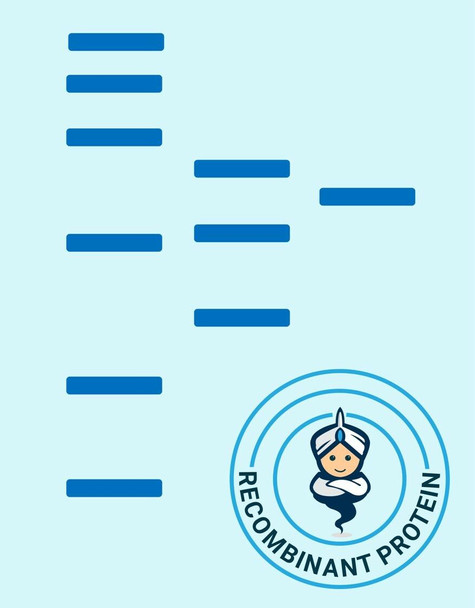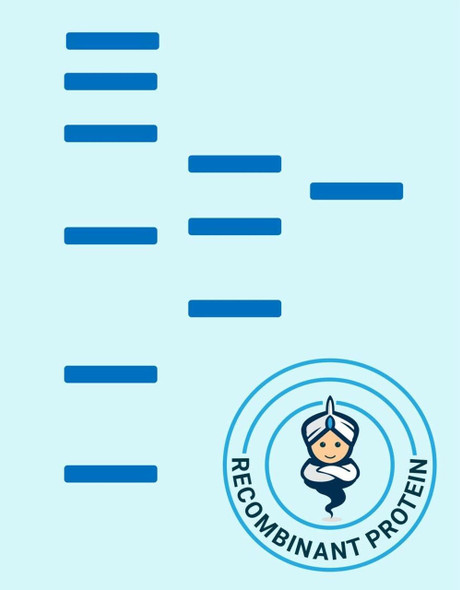Description
| Product Name: | Human MAPK14 Recombinant Protein |
| Product Code: | RPPB2575 |
| Size: | 20µg |
| Species: | Human |
| Target: | MAPK14 |
| Synonyms: | Mitogen-activated protein kinase 14, Mitogen-activated protein kinase p38 alpha, CSBP1, CSBP2, Mxi2, PRKM14, MAP kinase p38 alpha, MAX-interacting protein 2, EXIP, PRKM15, p38, Cytokine suppressive anti-inflammatory drug-binding protein, MAP kinase MXI2, Stress-activated protein kinase 2a, RK, CSAID binding protein, p38alpha Exip, SAPK2A, EC 2.7.11, EC 2.7.11.24. |
| Source: | Escherichia Coli |
| Physical Appearance: | Sterile Filtered colorless solution. |
| Formulation: | MAPK14 protein solution (0.5mg/ml) containing 20mM Tris-HCl buffer (pH8.0), 1mM DTT, 100mM NaCl and 10% glycerol. |
| Stability: | Store at 4°C if entire vial will be used within 2-4 weeks.Store, frozen at -20°C for longer periods of time. For long term storage it is recommended to add a carrier protein (0.1% HSA or BSA).Avoid multiple freeze-thaw cycles. |
| Purity: | Greater than 90.0% as determined by SDS-PAGE analysis. |
| Amino Acid Sequence: | MGSSHHHHHH SSGLVPRGSH MGSMSQERPT FYRQELNKTI WEVPERYQNL SPVGSGAYGS VCAAFDTKTG LRVAVKKLSR PFQSIIHAKR TYRELRLLKH MKHENVIGLL DVFTPARSLE EFNDVYLVTH LMGADLNNIV KCQKLTDDHV QFLIYQILRG LKYIHSADII HRDLKPSNLA VNEDCELKIL DFGLARHTDD EMTGYVATRW YRAPEIMLNW MHYNQTVDIW SVGCIMAELL TGRTLFPGTD HIDQLKLILR LVGTPGAELL KKISSESARN YIQSLTQMPK MNFANVFIGA NPLAVDLLEK MLVLDSDKRI TAAQALAHAY FAQYHDPDDE PVADPYDQSF ESRDLLIDEW KSLTYDEVIS FVPPPLDQEE MES |
MAPK14 belongs to the MAP kinase family and is most associated with p38 MAP kinases(MAPKs). MAPKs are activated mainly as a reaction to cellular stress and inflammatory cytokines, and inhibitors that target the MAPK14 and MAPK11 have demonstrated ability to cure inflammatory disease. The substrates of this kinase contain transcription regulator ATF2, MEF2C, and MAX, cell cycle regulator CDC25B, and tumor suppressor p53, which demonstrate the parts of MAPK14 in stress-related transcription, cell cycle regulation and genotoxic stress response.
MAPK14 Human Recombinant produced in E.Coli is a single, non-glycosylated polypeptide chain containing 383 amino acids (1-360 a.a.) and having a molecular mass of 43.7kDa.MAPK14 is fused to a 23 amino acid His-tag at N-terminus & purified by proprietary chromatographic techniques.
| UniProt Protein Function: | P38A: a proline-directed ser/thr MAP kinase, and one of four p38 kinases that play important roles in cellular responses to inflammatory cytokines, DNA damage, oxidative stress, and some GPCRs, leading to direct activation of transcription factors and of other downstream kinases including MSK1, MSK2, eEF2K, MK2, and PRAK. MSK1 and -2 play important roles in the rapid induction of immediate-early genes in response to stress or mitogenic stimuli. MK2 and -3 control gene expression mostly at the post-transcriptional level. eEF2K is important for the elongation of mRNA during translation. Ectodomain shedding of transmembrane proteins is regulated by p38 MAPKs as well. In response to inflammatory stimuli, p38 MAPKs phosphorylate the membrane-associated metalloprotease ADAM17, which then cleaves the ectodomain of TGF-alpha family ligands, a process leading to the activation of EGFR signaling and cell proliferation. In the nucleus, many transcription factors are phosphorylated and activated by p38 MAPKs in response to different stimuli. Classical examples include ATF1, ATF2, ATF6, ELK1, PTPRH, CHOPO, p53 and MEF2C and MEF2A. The p38 MAPKs are emerging as important modulators of gene expression by regulating chromatin modifiers and remodelers. The promoters of several genes involved in the inflammatory response, such as IL6, IL8 and IL12B, display a p38 MAPK-dependent enrichment of histone H3 phosphorylation on 'Ser-10' (H3S10ph) in LPS-stimulated myeloid cells. Interacts directly with HDAC3 interacts directly and selectively to repress ATF2 transcriptional activity, and regulate TNF gene expression in LPS-stimulated cells. Phosphorylates the ubiquitin ligase SIAH2, regulating its activity towards EGLN3. May also inhibit the lysosomal degradation pathway of autophagy by interfering with the intracellular trafficking of the transmembrane protein ATG9. Regulates the endocytosis of membrane receptors that depend on RAB5A. Regulates the clathrin-mediated internalization of EGFR induced by inflammatory cytokines and UV irradiation by phosphorylating the EGFR and RAB5A effectors. Required in mid-fetal development for the growth of embryo-derived blood vessels in the labyrinth layer of the placenta. Plays an essential role in developmental and stress-induced erythropoiesis, through regulation of EPO gene expression. Interacts with casein kinase II subunits CSNK2A1 and CSNK2B. Activated by cell stresses such as DNA damage, heat shock, osmotic shock, anisomycin and sodium arsenite, as well as pro-inflammatory stimuli such as LPS and IL-1. Phosphorylated by ZAP70 in an alternative activation pathway in response to TCR signaling in T-cells, a pathway is inhibited by GADD45A. Four alternatively spliced isoforms of the human protein have been observed. Isoform MXI2 activation is stimulated by mitogens and oxidative stress and only poorly phosphorylates ELK1 and ATF2. Isoform EXIP may play a role in the early onset of apoptosis |
| UniProt Protein Details: | Protein type:Protein kinase, CMGC; EC 2.7.11.24; Kinase, protein; Protein kinase, Ser/Thr (non-receptor); CMGC group; MAPK family; p38 subfamily; MAPK/p38 subfamily Chromosomal Location of Human Ortholog: 6p21.3-p21.2 Cellular Component: nucleoplasm; spindle pole; mitochondrion; cytoplasm; cytosol; nucleus Molecular Function:MAP kinase activity; MAP kinase kinase activity; protein serine/threonine kinase activity; protein binding; NFAT protein binding; ATP binding Biological Process: nerve growth factor receptor signaling pathway; activation of MAPK activity; stress-activated MAPK cascade; toll-like receptor 3 signaling pathway; osteoclast differentiation; toll-like receptor 5 signaling pathway; cell surface receptor linked signal transduction; regulation of transcription factor activity; transmembrane receptor protein serine/threonine kinase signaling pathway; chondrocyte differentiation; toll-like receptor 4 signaling pathway; cartilage condensation; platelet activation; mitochondrion organization and biogenesis; skeletal muscle development; transcription, DNA-dependent; positive regulation of blood vessel endothelial cell migration; glucose metabolic process; toll-like receptor 2 signaling pathway; regulation of transcription from RNA polymerase II promoter; muscle cell differentiation; response to muramyl dipeptide; DNA damage checkpoint; striated muscle cell differentiation; positive regulation of transcription from RNA polymerase II promoter; fatty acid oxidation; toll-like receptor 9 signaling pathway; myoblast cell differentiation involved in skeletal muscle regeneration; apoptosis; cell morphogenesis; chemotaxis; signal transduction; toll-like receptor 10 signaling pathway; lipopolysaccharide-mediated signaling pathway; angiogenesis; MyD88-independent toll-like receptor signaling pathway; positive regulation of erythrocyte differentiation; organelle organization and biogenesis; DNA damage response, signal transduction; positive regulation of myoblast differentiation; MyD88-dependent toll-like receptor signaling pathway; peptidyl-serine phosphorylation; positive regulation of protein import into nucleus; Ras protein signal transduction; toll-like receptor signaling pathway; innate immune response; positive regulation of muscle cell differentiation; gene expression; cell motility; vascular endothelial growth factor receptor signaling pathway; blood coagulation |
| NCBI Summary: | The protein encoded by this gene is a member of the MAP kinase family. MAP kinases act as an integration point for multiple biochemical signals, and are involved in a wide variety of cellular processes such as proliferation, differentiation, transcription regulation and development. This kinase is activated by various environmental stresses and proinflammatory cytokines. The activation requires its phosphorylation by MAP kinase kinases (MKKs), or its autophosphorylation triggered by the interaction of MAP3K7IP1/TAB1 protein with this kinase. The substrates of this kinase include transcription regulator ATF2, MEF2C, and MAX, cell cycle regulator CDC25B, and tumor suppressor p53, which suggest the roles of this kinase in stress related transcription and cell cycle regulation, as well as in genotoxic stress response. Four alternatively spliced transcript variants of this gene encoding distinct isoforms have been reported. [provided by RefSeq, Jul 2008] |
| UniProt Code: | Q16539 |
| NCBI GenInfo Identifier: | 2499600 |
| NCBI Gene ID: | 1432 |
| NCBI Accession: | Q16539.3 |
| UniProt Secondary Accession: | Q16539,O60776, Q13083, Q14084, Q8TDX0, A6ZJ92, A8K6P4 B0LPH0, |
| UniProt Related Accession: | Q16539 |
| Molecular Weight: | 41,293 Da |
| NCBI Full Name: | Mitogen-activated protein kinase 14 |
| NCBI Synonym Full Names: | mitogen-activated protein kinase 14 |
| NCBI Official Symbol: | MAPK14�� |
| NCBI Official Synonym Symbols: | RK; p38; CSBP; EXIP; Mxi2; CSBP1; CSBP2; CSPB1; PRKM14; PRKM15; SAPK2A; p38ALPHA�� |
| NCBI Protein Information: | mitogen-activated protein kinase 14; MAP kinase 14; p38alpha Exip; p38 MAP kinase; MAP kinase Mxi2; MAP kinase p38 alpha; CSAID-binding protein; Csaids binding protein; MAX-interacting protein 2; stress-activated protein kinase 2A; p38 mitogen activated protein kinase; mitogen-activated protein kinase p38 alpha; cytokine suppressive anti-inflammatory drug binding protein; cytokine suppressive anti-inflammatory drug-binding protein |
| UniProt Protein Name: | Mitogen-activated protein kinase 14 |
| UniProt Synonym Protein Names: | Cytokine suppressive anti-inflammatory drug-binding protein; CSAID-binding protein; CSBP; MAP kinase MXI2; MAX-interacting protein 2; Mitogen-activated protein kinase p38 alpha; MAP kinase p38 alpha; Stress-activated protein kinase 2a |
| Protein Family: | MIP-related peptides |
| UniProt Gene Name: | MAPK14�� |
| UniProt Entry Name: | MK14_HUMAN |










